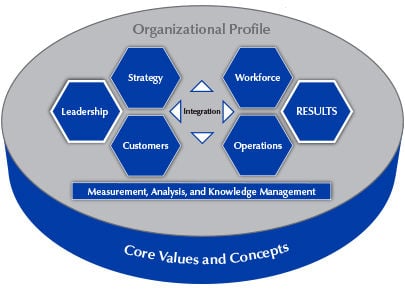In order to stay relevant and competitive, organisations have to find ways to improve business performance across the board; one of the best ways of succeeding is with continuous process improvement. Brenda Lopez, Business Process Consultant, National Baldrige Examiner and Certified Green Belt Lean Six Sigma, explains the Baldrige Excellence Framework and how it can be exactly what the business doctor ordered when trying to improve business performance...
The Baldrige Excellence Framework provides organisations with a holistic approach to improve the overall quality management system and organisational effectiveness by promoting continuous improvement. This approach encourages U.S. organisations to asses and evaluate their internal key processes and performance measures against the provided criteria.
The quality management framework is divided into seven critical categories:
- Leadership
- Strategy
- Customers
- Knowledge Management
- Workforce
- Operations
- Performance Measures or Results
The establishment of the Malcolm Baldrige National Quality Award (MBNQA), a Presidential Award, was to advocate the benefits of implementing the Baldrige Excellence Framework.
Today, many organisations have been able to implement and use the framework as a process management tool, while continuing to achieve higher levels of performance and excellence across all areas.
Every organisation, regardless of size and sector, can implement the Excellence Framework and apply for the MBNQA. Organisations who excel in performance are recognised by receiving the MBNQA and are encourage to share their best practices with others.
The return on investment of applying the Baldrige Excellence Framework and receiving the MBNQA adds great value to the organisation and creates an environment of learning and development.

How Baldrige Can Help You to Improve Business Performance
While there are other tools or frameworks for process improvement, the Baldrige Excellence Framework helps organisations accomplish their mission, aligns strategic goals and objectives with key performance measures, and supports in the pursuit of excellence through continuous self-assessments and evaluations.
The harmonisation and linkage of key processes described in each one of these categories facilitates the achievement of goals and objectives while creating a sustainable and more competitive organisation. In addition, the organisation can also establish its own quality program that can meet and exceed the intensifying demands of their customers, which leads to overall success and satisfaction.

In a nutshell, the framework yields a comprehensive view of the organisation’s current state, in order for the business to identify what needs to be accomplished in order to achieve organisational excellence. The Baldrige Framework not only provides an integrated management system to achieve ongoing improvements, but also promotes an environment of continuous learning.
As we know, the business environment is constantly changing and becoming more competitive. Businesses are looking into long-term improvements that allows them to remain relevant, innovative, and competitive.
Using the Excellence Framework, organisations are able to analyse and highlight their strengths, key processes, and find new ways to improve business performance through business process improvement across all areas and departments.
Improvements do not occur over night - they are rather the result of systematic process evaluations and commitment to quality and excellence.
The 7 Key Steps for Achieving Organisational Effectiveness
Whether your organisation is big or small, it is never too late to change and/or create change by implementing a performance excellence framework.
The Baldrige Excellence Framework sets a foundation of effective and systematic processes, high performing results, and linkages used across the organisation. The framework provides a common vocabulary that facilitates an environment of excellence and continuous improvement. It allows the business to understand the importance of implementing a business model that brings consistency to the organisation’s management system.
Through effective processes, your business can determine intelligent risks, understand its competitive environment, and take action in order to drive innovation and improve business performance. Organisations will have the opportunity to learn the importance of integrating their customers, partners, and stakeholders into organisational change processes that will have lasting impacts to their organisation and its future state.

If your organisation is ready to learn and conduct a full assessment using the Baldrige Framework, here are some ways to help facilitate the process improvement journey:
- Understand the commitment:
- All your senior leaders, managers, and staff need to understand the commitment and hours of hard work it takes to describe each process required by the framework.
- Commitment should be demonstrated by senior leaders and cascaded down to the process owners in order to ensure a positive experience during your Baldrige journey
- Select your key players:
- Category leaders (or champions) should be designated in order to check and control progress for each category.
- Category leaders should also identify process owners as they will be the ones describing key processes as well as proving relevant data that describes process effectiveness.
- Train your key players:
- Training is key to a successful Baldrige journey. Category leaders and process owners should be able to understand the seven different categories, the requirements, and how processes should be mapped.
- They should also understand the linkage between the processes described in categories one through six and category seven (results). Training is available every year through the National Institute of Standards and Technology (NIST), or your organisation can also find many independent consultants that offer training throughout the year.
- Gather information:
- Gathering the correct information will take time, but it is important to understand what the framework requires from your organisation and departments.
- Eliminate unnecessary data and only describe key processes to full extent. Data also includes expected results that will be described in category seven.
- Roll up your sleeves and get started:
- Start with the organisational profile. It describes the overall purpose, environment, customers, partners, stakeholders, and key communities.
- It also lists regulatory requirements, as well as workforce segments, but, most importantly, its products and services given to the customers.
- Keep improving:
- Once you have finished your Baldrige journey and received feedback from qualified examiners, use that feedback to modify your processes and improve.
- Seek opportunities for improvement, take risks, and continue to innovate.
- Share best practices:
- Sharing best practices is probably the best way to create an environment of learning throughout the organisation. It does not do your business any good to keep its achievements in the dark.
- Share your best practices internally and externally, learn from others, apply new approaches and soon everyone will be fully committed to continuous improvement and excellence as part of their daily jobs.
What we need to understand is that “quality is never an accident; it is always the result of high intention, sincere effort, intelligent direction and skillful execution; it represents the wise choice of many alternatives.” - William A. Foster
If you are looking for more ways to improve business performance through continual improvement, please feel free to download Triaster's  .
.
Related articles:
How do I create a culture of Continuous Improvement?
The 4 Essential Pillars of Business Continual Improvement [Infographic]
Written by Brenda Lopez
As a Business Process Consultant Brenda Lopez enjoys helping organisations improve their productivity. Brenda Lopez has also been recognised by the National Institute of Standards and Technology for outstanding service to the Nation as a member of the 2017 Malcolm Baldrige National Quality Award Board of Examiners.
